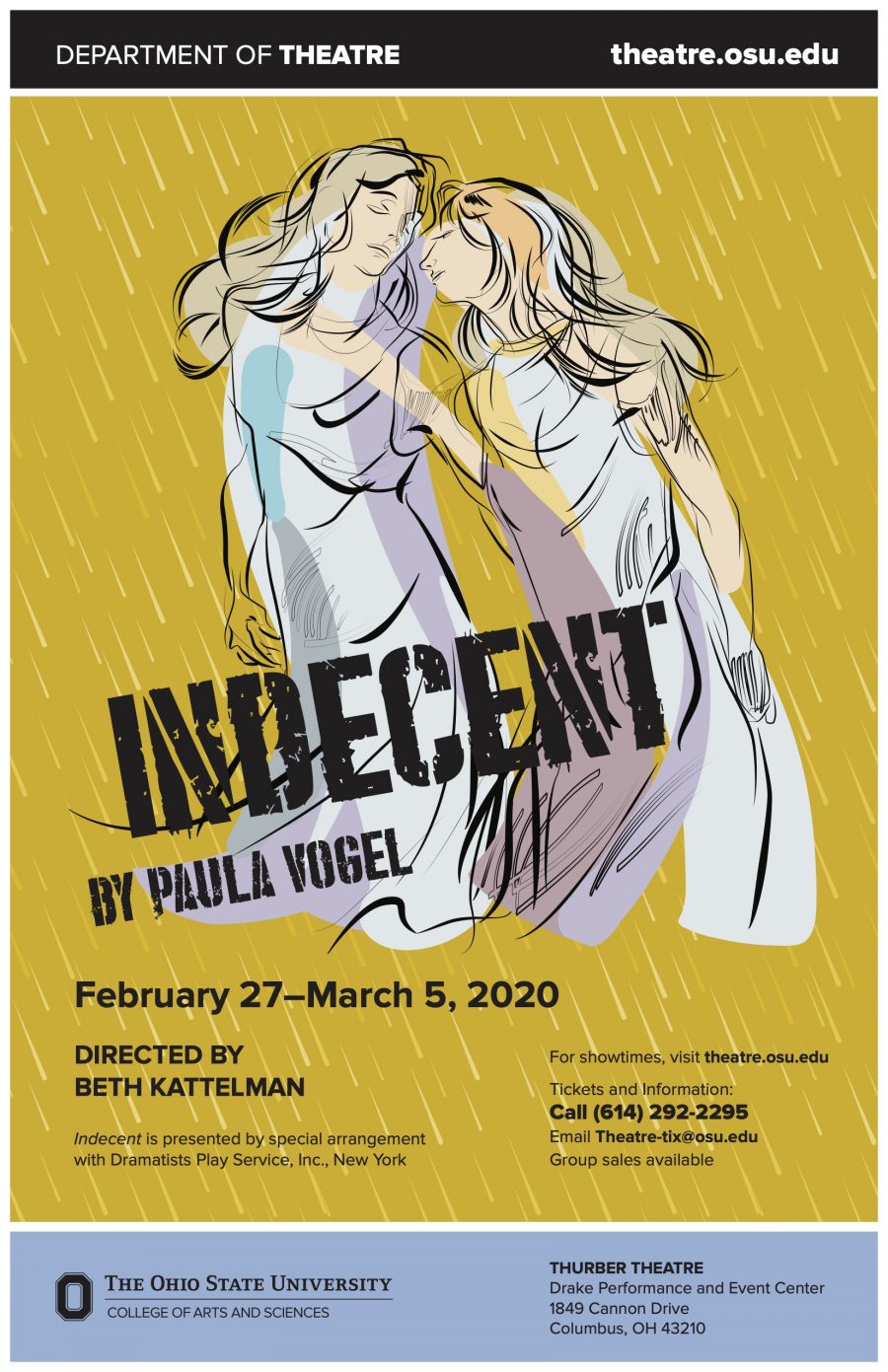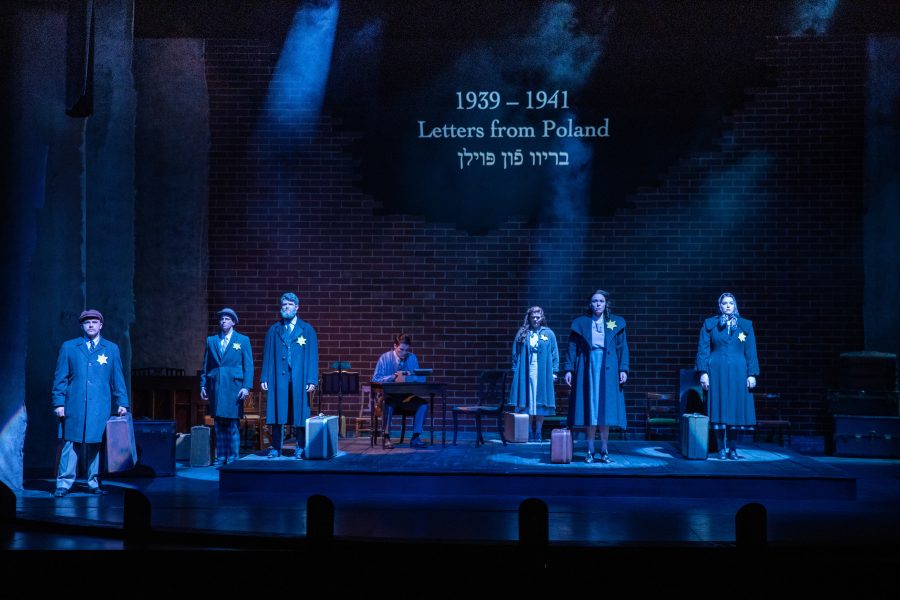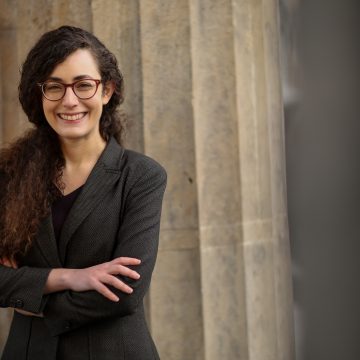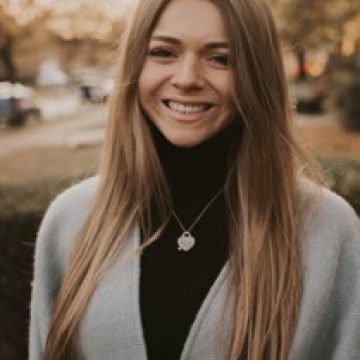Sheet music for “What Can You Mach! S’iz America” from the Fraydele Oysher Collection at the Theatre Research Institute. Courtesy of Beth Kattelman, Curator, Theatre Research Institute, The Ohio State University.
Teaching with the Digital Yiddish Theatre Project
Sonia Gollance, Caitlin Hatten
The 2019-2020 academic year was a strange time to start reviving a Yiddish Studies program. When I started teaching Yiddish 3371: Yiddish Literature in Translation at The Ohio State University this past Spring Semester, the main challenge I envisioned was one that I had set for myself: integrating the Digital Yiddish Theatre Project into my literature class. I had decided that, instead of doing a more traditional survey of canonical Yiddish literature, I would focus my class on performance, broadly construed to include works that were designed to be performed (like plays and medieval epic) and those that described performance (cantorial singing, dance, klezmer music, even public oration). I had several reasons for designing my class with this focus. I liked the idea of bringing a new, digital tool into a General Education class, which could demonstrate the range and vitality of Yiddish scholarship today. My own research deals with Yiddish performance culture, so focusing the class in this direction would be a way for me to share the topics I found most exciting with students in a context where we could all learn more about performance together. OSU happens to have two Yiddish theatre collections (here and here) in its library Special Collections, which was a great excuse for a field trip. Finally, we happened to have a number of Yiddish-related events going on during the semester, including a student theatre performance of Paula Vogel’s Indecent and a reading of an English translation of Sholem Asch’s God of Vengeance.

Poster for the OSU 2020 production of Indecent.
In designing the class, I made a point of weaving in the DYTP in various ways. The previous semester, my first at OSU, I had given my Yiddish 2241: Yiddish Culture class the opportunity to explore the DYTP blog in pairs, and I liked the idea of expanding upon this activity in a more sustained way. I ended up giving the students in Yiddish 3371 a “scavenger hunt” activity at the beginning of the semester, where they got to poke around the site, answer questions about the DYTP and specific categories of blog entries, and give me a clearer sense of the types of blog posts that they found particularly compelling. Although most of our readings came from books, we also read Jessica Kirzane’s translation of Miriam Karpilove’s “Theatre: A Sketch” from the blog as a way of thinking through the lack of published translations of plays by women. I also referred to DYTP initiatives and team members at various points in the semester, such as when I projected a PowerPoint slide with the titles of all the Avrom Goldfaden plays that are available on Plotting Yiddish Drama or when we watched a video of Joel Berkowitz reading the part of villainous Reb Yoysefkhe from Aaron Halle Wolfssohn’s Lakhtzin un fremelay (Silliness and Sanctimony) and I got to point out that actually the DYTP co-founder is actually a good guy. Most significantly, our written assignments were styled after DYTP blog posts, including a listicle and an interview with someone who was involved in Yiddish culture. Students took their inspiration from blog posts such as David Mazower’s “10 Things You Need to Know About God of Vengeance” and Joel Berkowitz’s “Interview: Interview: Indecent Playwright Paula Vogel and Director Rebecca Taichman Playwright Paula Vogel and Director Rebecca Taichman. At the end of the semester, students picked one of their essays to revise, and then (following a round of peer-review with each other) did a last revision for their final project.
When the COVID-19 pandemic hit, we were on Spring Break, and still had one more blog post assignment to complete. It was a distracting time, and I personally found it heartbreaking to see how friends in the Yiddish performance world were reeling from the cancellation of in-person shows. As they began to regroup and we got ready to launch our remote classes, I considered how to make an assignment for my students that engaged with both our course content and our dizzying new reality. Ultimately, I crowd-sourced a list of organizations and artists in the Yiddish world and asked my students to pick one to profile for their blog post. In the rest of this blog post, you can read more about this assignment and Caitlin Hatten’s short essay about how the YIVO Institute for Jewish Research responded to the pandemic.
— Sonia Gollance

Students in Sonia Gollance’s course, Yiddish Literature in Translation, visit OSU’s Special Collections and the Lawrence and Lee Theatre Research Institute. Photo: Beth Kattelman.
Short Essay #3
The COVID-19 pandemic has had a huge impact on our lives and those of people all around the world. Institutions, industries, and individuals have struggled to find ways to cope with this crisis and support each other in this new, unpredictable reality. Our Yiddish 3371 class is not the only example of Yiddish culture going online. Yiddish cultural organizations, klezmer musicians, archives, and the Folksbiene Yiddish theatre company have all found ways to go virtual, connect with audiences, and support their artists. For our third short assignment, you will reflect upon how an artist, cultural activist, or organization in the Yiddish (performance) world has responded to this current health crisis. You may find it useful to see how Amanda (Miryem-Khaye) Seigel writes in a first-person voice about an institution in her DYTP blog post “Biz 120: The Yiddish Artists and Friends Actors’ Club at 85.” If a component of your piece is a performance review, you might also want to consult Debra Caplan’s DYTP blog post “Magic and Melody Delight In a Yiddish Fairytale Reborn.”

A scene from the OSU staging of Indecent. Photographer: Jodi Miller.
This piece does not have as rigid a structure as previous assignments, but there are certain components that should be included in whatever order makes the most sense to you. Your reflective essay should include 1-2 paragraphs about the individual or organization you are profiling. What is this individual or organization best known for? Why did you choose this particular individual or organization? You should also include information about how the individual or organization has been affected by the pandemic and what kinds of shifts they needed to make—this information can be brief, but at least a few straightforward statements will clarify the situation for your readers.
In addition to this background research, you will also need to spend some time exploring the way that the individual or organization you are profiling has responded to the current health crisis. If they are putting performances online, watch a performance and talk about what the experience was like. If they are making resources available for free, spend some time looking at those resources and share something you’ve learned. If they are producing content that is related to the COVID-19 pandemic, say something about how effective you think it might be or how much of a change it is from prior content they’ve created. Additionally, you should reference at least one of the major themes of this course or the texts we’ve read in class.

Student Essay
YIVO in the Time of COVID-19
The COVID-19 pandemic is inescapable. No matter who you are or where you live, your life has been changed because of this health crisis. COVID-19 has had a major impact on our daily lives and will leave a lasting impact long after the risk has been mitigated. With the closing of schools, most businesses, and even parks, life as we know it has been moved completely online. It has been a few weeks since many states have employed their “Stay at Home” orders. Despite this sudden change, institutions and communities have come together to support one another in many ways during this crisis. Many businesses and organizations, including Yiddish cultural organizations, have found creative ways to remain connected with their audiences virtually.
The Yidisher visnshaftlekher institute (known now as YIVO, The Institute for Jewish Research) is one of the leading research organizations focused on the history and culture of Eastern European Jewry. Their mission is to preserve and study the history of these Jewish communities as well as share knowledge of Ashkenazi Jewish culture. It was originally established in 1925 in Wilno, Poland (today Vilnius, Lithuania) and since 1940 has had it headquarters in New York City. Founded with the support of leading intellectuals and scholars of the time such as Albert Einstein and Sigmund Freud, YIVO’s archives and libraries contain the most comprehensive collection of Eastern European Jewish materials in the world. The collections are expansive and contain information about music, theatre, and art. The library is home to one of the world’s largest collections of materials in or related to Yiddish.
YIVO has transformed part of their organization to accommodate the new social distancing guidelines. Although the onsite exhibitions and events have been suspended, YIVO’s Shine Online Educational Series continues to move forward in providing an educational experience in your own home. YIVO describes their online educational series as filling the gap in Jewish Studies education by providing courses on topics of Jewish culture that are not formally taught in a school’s curricula. The courses available specialize in Ashkenazi literature, language, art, music, and more. Due to COVID-19-related restrictions, YIVO is offering their Shine Online courses for free. These free courses aim to bring positivity and meaningful content to people during this time.
There are plenty of courses to choose from on the site and each is taught experts in that field. “A Seat at the Jewish Table: A Journey into Jewish Food” is an educational experience on Ashkenazic food featuring chef Joan Nathan, author of King Solomon’s Table, Jake Dell, owner of Katz’s Delicatessen, and many more. Not only does this course offer lectures and archival sources, it provides recipes of traditional Jewish food from renowned chefs. “Oh Mama, I’m in Love! The Story of the Yiddish Stage” outlines the history of Jewish performance with plenty of lecture videos about famous and influential directors, actors and playwrights. Each class can be completed anytime and at your own pace.
I wanted to share this information about this particular organization because—while being stuck at home due to school closures—I’ve reflected on how in-person learning, as well as access to materials is important. YIVO has provided free access to its audience to allow those who want to continue their studies from their home. I decided to sign up for the Jewish performance history course to learn more about Ashkenazic theatre culture. Each week a new unit is released as well as opportunities to post on a discussion board and connect with others in this course. Each topic in the course is accompanied by a video lecture of the general theme and archived documents about a play that falls within that theme. For example, I spent some time learning about maskillic dramas that included documents from Laykhtzin und fremelay (Silliness and Sanctimony) by Aaron Wolfssohn, which was a translation I read in Professor Gollance’s Yiddish 3371: Yiddish Literature in Translation class this past semester. During this time of panic and uncertainty, YIVO is providing positivity and a connection to great Eastern European Jewish works right at home.
— Caitlin Hatten

